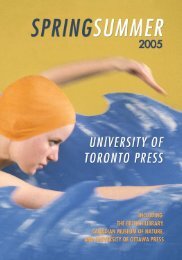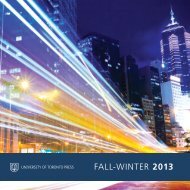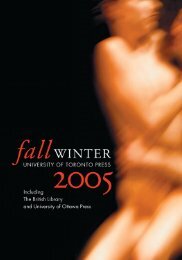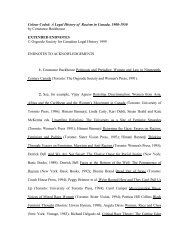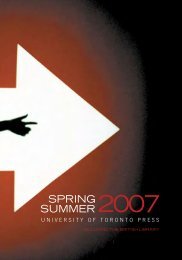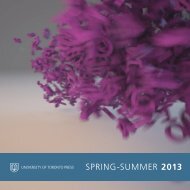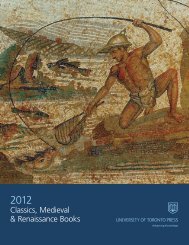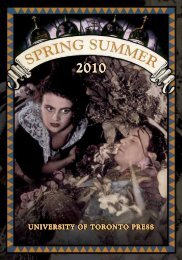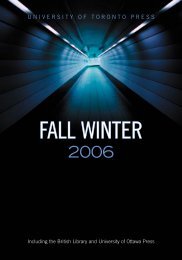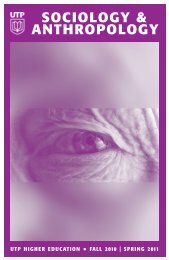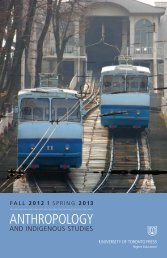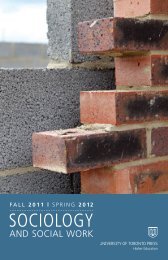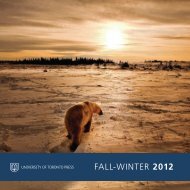ANTHROPOLOGY - University of Toronto Press Publishing
ANTHROPOLOGY - University of Toronto Press Publishing
ANTHROPOLOGY - University of Toronto Press Publishing
You also want an ePaper? Increase the reach of your titles
YUMPU automatically turns print PDFs into web optimized ePapers that Google loves.
FALL 2011 | SPRING 2012<br />
Anthropology<br />
And indigenous Studies
Anthropology and Indigenous studies<br />
Table <strong>of</strong> Contents<br />
Anthropology 1<br />
Anthropological Theory and Methods 3<br />
Teaching Culture:<br />
UTP Ethnographies for the Classroom 4<br />
Archaeology 8<br />
Indigenous Studies 9<br />
Indigenous History 10<br />
Indigenous Politics 13<br />
Indigenous Law 14<br />
Indigenous Education 15<br />
Indigenous Health 16<br />
Index 17<br />
<strong>University</strong> <strong>of</strong> <strong>Toronto</strong> <strong>Press</strong><br />
Higher Education Division<br />
The aim at UTP Higher Education is to<br />
publish materials for course use that<br />
are pedagogically valuable and that<br />
contribute to ongoing scholarship.<br />
Working as a division within UTP <strong>of</strong>fers<br />
exciting opportunities to pursue this<br />
goal and to meet the changing needs<br />
<strong>of</strong> teaching and scholarship in North<br />
America. The possibilities for rethinking<br />
how texts can be used in the classroom,<br />
along with new formats for their delivery,<br />
are endless, and UTP looks forward<br />
to partnering with instructors and<br />
scholars in this innovative endeavour!<br />
UTP Higher Education acknowledges with<br />
thanks the assistance <strong>of</strong> Livres Canada Books.<br />
UTP Higher Education gratefully acknowledges<br />
the financial support <strong>of</strong> the Government<br />
<strong>of</strong> Canada through the Canada Book<br />
Fund for our publishing activities.<br />
The UTP Higher Education Division has carved out a special niche in academic publishing with books that<br />
“ are rich, rigorous, and challenging while at the same time engaging and accessible. UTP Higher Ed staff<br />
members are highly pedagogically aware, and interested in the creative learning and teaching possibilities<br />
associated with these texts.<br />
– Alan Sears, Ryerson <strong>University</strong> ”<br />
The Teaching Culture series is a marvellous resource for instructors searching for ethnographic case studies<br />
“ that are contemporary, engaging, and provocative, yet written specifically with undergraduate students in<br />
mind. With clarity and personal warmth, the books introduce students to the core methods and orienting<br />
frameworks <strong>of</strong> ethnographic research and provide a compelling entry point to some <strong>of</strong> the most urgent<br />
issues faced by people around the globe today.<br />
– John Barker, <strong>University</strong> <strong>of</strong> British Columbia ”
Anthropology<br />
NEW!<br />
Indigenous Peoples <strong>of</strong> North America:<br />
A Concise Anthropological Overview<br />
BY ROBERT J. MUCKLE (CAPILANO UNIVERSITY)<br />
Spring 2012 6x9 paper 208pp 978-1-4426-0356-1<br />
Us & CDn $24.95<br />
Most introductory texts<br />
on North American<br />
Indigenous peoples are<br />
long, expensive, and<br />
exhaustive in coverage.<br />
They leave little time<br />
or room for instructors<br />
to be more creative in<br />
assigning other materials<br />
(e.g. ethnographies,<br />
case studies, readers, films, etc.). This text<br />
<strong>of</strong>fers a corrective to that trend by providing<br />
a brief, thematic overview <strong>of</strong> the key<br />
issues facing Indigenous peoples in North<br />
America from pre-history to the present.<br />
Rather than organize the book by culture<br />
area, the author situates culture area analysis<br />
within the thematic approach, and as<br />
a whole, the text addresses topics such as<br />
historical context, archaeology, pre-history,<br />
traditional lifeways, colonialism, and contemporary<br />
Indigenous culture. The result is a<br />
remarkably affordable overview that <strong>of</strong>fers<br />
a big-picture introduction while allowing<br />
instructors flexibility in how they provide<br />
detailed information on various cultures.<br />
C o n t e n t s :<br />
1. Situating the Indigenous Peoples <strong>of</strong> North America<br />
2. Studying the Indigenous Peoples <strong>of</strong> North America<br />
through the Lens <strong>of</strong> Anthropology<br />
3. Comprehending North American Archaeology<br />
4. Studying Population, Languages, and Cultures in<br />
North America as they were at A.D. 1500<br />
5. Overview <strong>of</strong> Traditional Lifeways<br />
6. Understanding the Colonial Experience<br />
7. Contemporary Conditions, Nation-building,<br />
and Anthropology<br />
Applied Anthropology in Canada:<br />
Understanding Aboriginal Issues,<br />
Second Edition<br />
BY EDWARD J. HEDICAN (UNIVERSITY OF GUELPH)<br />
2008 6x9 paper 320pp 978-0-8020-9541-1<br />
Us & CDn $29.95<br />
“This is a very valuable book,<br />
one long overdue and one that<br />
will be <strong>of</strong> great value to a<br />
variety <strong>of</strong> undergraduate<br />
courses. Hedican’s vision <strong>of</strong><br />
anthropology is one in which<br />
the traditional strengths <strong>of</strong> the<br />
discipline are sustained, where<br />
we practice our craft<br />
unapologetically, and where<br />
we are prepared to ensure that our interests are also<br />
relevant to the needs <strong>of</strong> the communities in which we<br />
study.” – Wayne Warry, Anthropologica<br />
The second edition <strong>of</strong> this classic work<br />
takes stock <strong>of</strong> current research on<br />
Indigenous affairs and <strong>of</strong>fers an assessment<br />
<strong>of</strong> Aboriginal issues in Canada from<br />
the perspective <strong>of</strong> applied anthropology.<br />
Hedican covers advocacy roles in<br />
Aboriginal studies, the ethics <strong>of</strong> applied<br />
research, policy issues in community<br />
development, the political context <strong>of</strong> the<br />
self-government debate, and the dilemma<br />
<strong>of</strong> Aboriginal status and identity in Canada.<br />
C o n t e n t s :<br />
1. Introduction<br />
2. Anthropology and Aboriginal Studies<br />
3. Research Strategies: Advocacy in Anthropology<br />
4. The Controversial Side <strong>of</strong> Applied Anthropology:<br />
Notes from Northern Ontario<br />
5. Aboriginal Policy Issues: Anthropological<br />
Perspectives<br />
6. Development in Aboriginal Communities: Economic<br />
Strategies and Policies<br />
7. The Political Context <strong>of</strong> Aboriginal Issues:<br />
Self-government and Institutional Structures<br />
8. The Ethnopolitics <strong>of</strong> Aboriginal Status and Identity<br />
9. Applied Anthropology: Challenges for Today<br />
and Tomorrow<br />
For more information, visit utppublishing.com 1
XXXXX Anthropology<br />
RECENTLY PUBLISHED!<br />
Trickster: An Anthropological Memoir<br />
BY EILEEN KANE<br />
2010 6x9 paper 248pp 978-1-4426-0178-9<br />
Us & CDn $26.95<br />
“A real page turner. Kane has turned her first fieldwork<br />
experience into an engaging ‘Margaret Mead meets<br />
Tony Hillerman’ narrative, with vivid characters, many<br />
tricksters, and even a mysterious death.”<br />
– Louise Lamphere, <strong>University</strong> <strong>of</strong> New Mexico<br />
“Trickster should become essential reading for young<br />
anthropologists, if only because <strong>of</strong> its ruminations<br />
about the discipline as theory and praxis.”<br />
– Michael Hittman, Long Island <strong>University</strong><br />
A young trainee<br />
anthropologist leaves<br />
her violent Mafia-run<br />
hometown—Youngstown,<br />
Ohio—to study<br />
an “exotic” group, the<br />
Paiute Indians <strong>of</strong> Nevada.<br />
This is 1964; she’ll be<br />
“the expert,” and they’ll<br />
be “the subjects.” The<br />
Paiute elders have other ideas. They’ll<br />
be “the parents.” They set themselves two<br />
tasks: to help her get a good grade on<br />
her project and to send her home quickly<br />
to her new bridegroom. They dismiss her<br />
research topic and introduce her instead<br />
to their spirit creature, the outrageously<br />
mischievous rule-breaking trickster, Coyote.<br />
Why do the Paiutes love Coyote? Why do<br />
Youngstown mill workers vote for Mafia<br />
candidates for municipal <strong>of</strong>fice? Tricksters<br />
become key to understanding how<br />
oppressed groups function in a hostile world.<br />
Anthropology Matters!<br />
BY SHIRLEY A. FEDORAK<br />
2007 7x9 paper 234pp 978-1-4426-0108-6<br />
Us & CDn $32.95<br />
“Introductory students will love it!”<br />
– Todd Sanders, <strong>University</strong> <strong>of</strong> <strong>Toronto</strong><br />
This book invites<br />
students to examine<br />
contemporary and<br />
sometimes controversial<br />
issues and<br />
global concerns from<br />
an anthropological<br />
perspective, in an<br />
attempt to develop a<br />
greater appreciation<br />
for the value <strong>of</strong> cultural diversity. Chapters<br />
on the anthropology <strong>of</strong> shopping, ethnic<br />
conflict, female circumcision, the practice<br />
<strong>of</strong> purdah, and same-sex marriage help to<br />
highlight the relevance <strong>of</strong> anthropology.<br />
Pop Culture: The Culture <strong>of</strong><br />
Everyday Life<br />
BY SHIRLEY A. FEDORAK<br />
2009 6x9 paper 166pp 978-1-4426-0124-6<br />
Us & CDn $22.95<br />
“This text is important for any introductory anthropology<br />
course, particularly in conveying to students the<br />
relevance <strong>of</strong> anthropology by engaging with the very<br />
aspects <strong>of</strong> popular culture that are significant in their<br />
everyday lives.”<br />
– Kristin L. Dowell, <strong>University</strong> <strong>of</strong> Oklahoma<br />
C o n t e n t s :<br />
1. What is Popular Culture?<br />
2. The Study <strong>of</strong> Popular Culture<br />
3. Television<br />
4. Music<br />
5. The Internet and Virtual Communities<br />
6. Folk Art<br />
7. Body Art and Adornment<br />
8. The Symbolic Meaning <strong>of</strong> Food<br />
9. Sports<br />
10. Wedding Rituals<br />
2 <strong>ANTHROPOLOGY</strong> AND INDIGENOUS STUDIES FALL 2011 | SPRING 2012
AnthropologICAl theory And Methods<br />
Readings for a History <strong>of</strong><br />
Anthropological Theory, Third Edition<br />
EDITED BY PAUL A. ERICKSON (ST. MARY’S<br />
UNIVERSITY) AND LIAM D. MURPHY (CALIFORNIA<br />
STATE UNIVERSITY, SACRAMENTO)<br />
2010 7x9 paper 632pp 978-1-4426-0069-0<br />
Us & CDn $64.95<br />
“This collection gets better<br />
with each edition! Updated<br />
article selections and the<br />
addition <strong>of</strong> commentaries on<br />
‘why theory matters’ make<br />
this an even more perfect<br />
companion to the textbook,<br />
and a must for introductory<br />
and history <strong>of</strong> theory classes<br />
in anthropology.”<br />
– Linda-Anne Rebhun, <strong>University</strong> <strong>of</strong> California, Merced<br />
This edition includes several new readings<br />
as well as three new original essays written<br />
by contemporary anthropologists. The glossary<br />
and the discussion questions have also<br />
been significantly expanded and revamped.<br />
A History <strong>of</strong> Anthropological Theory,<br />
Third Edition<br />
BY PAUL A. ERICKSON AND LIAM D. MURPHY<br />
2008 7x9 paper 296pp 978-1-4426-0110-9<br />
Us & CDn $29.95<br />
“The third edition <strong>of</strong> an already popular book hits the<br />
mark once again. New life is breathed into theory<br />
with the ‘stories’ <strong>of</strong> contemporary anthropologists,<br />
who bring their uses <strong>of</strong> anthropological theory to<br />
life for the readers.”<br />
– Yolanda Moses, <strong>University</strong> <strong>of</strong> California, Riverside<br />
s p e C I A l C o M B I n e d p r I C e :<br />
A History <strong>of</strong> Anthropological Theory<br />
may be ordered together with Readings<br />
for a History <strong>of</strong> Anthropological<br />
Theory at a special discounted price.<br />
For more information, please contact<br />
requests@utphighereducation.com.<br />
Anthropology: A Student’s Guide to<br />
Theory and Method, Second Edition<br />
BY STANLEY R. BARRETT (UNIVERSITY OF GUELPH)<br />
2009 6x9 paper 288pp 978-0-8020-9612-8<br />
Us & CDn $29.95<br />
Stanley R. Barrett’s<br />
Anthropology: A Student’s<br />
Guide to Theory and<br />
Method has long been<br />
a premiere sourcebook<br />
for students, providing<br />
a comprehensive<br />
overview <strong>of</strong> both theory<br />
and method in the<br />
discipline. In the second<br />
edition, Barrett’s discussion <strong>of</strong> the origins<br />
and evolution <strong>of</strong> anthropology is augmented<br />
by sections addressing recent changes<br />
and ongoing questions in the field.<br />
The second edition incorporates important<br />
new material on questions <strong>of</strong> culture versus<br />
power, Max Weber’s thought, the potential<br />
<strong>of</strong> applied anthropology, and the rise <strong>of</strong><br />
public anthropology, while briefly touching<br />
on the anthropology <strong>of</strong> globalization.<br />
Auto-Ethnographies: The Anthropology<br />
<strong>of</strong> Academic Practices<br />
EDITED BY ANNE MENELEY (TRENT UNIVERSITY)<br />
AND DONNA J. YOUNG (UNIVERSITY OF TORONTO)<br />
2005 6x9 paper 255pp 978-1-5511-1684-6<br />
Us & CDn $29.95<br />
How has the “business” <strong>of</strong> higher<br />
education affected the environment in<br />
which academics work? Who should be<br />
able to hold anthropologists ethically<br />
responsible—the research institution that<br />
sponsors the fieldwork or the community<br />
<strong>of</strong> people being studied? What happens<br />
when academics step out <strong>of</strong> the ivory tower<br />
and into the public realm? These are some<br />
<strong>of</strong> the questions posed in this innovative<br />
and insightful collection <strong>of</strong> essays.<br />
For more information, visit utppublishing.com 3
teAChIng Culture: utp ethnogrAphIes For the ClAssrooM<br />
SERIES EDITOR: JOHN BARKER, UNIVERSITY OF BRITISH COLUMBIA<br />
The Teaching Culture series is comprised <strong>of</strong> accessibly written ethnographies, specifically designed<br />
for use in undergraduate classrooms. They <strong>of</strong>fer teaching tools rich in pedagogical value.<br />
ForthCoMIng In 2012:<br />
Made in Madagascar: Mining and Minding Ankarana’s Natural Wonders<br />
BY ANDREW WALSH (UNIVERSITY OF WESTERN ONTARIO)<br />
Fields <strong>of</strong> Play: The Social Construction <strong>of</strong> Children’s Sport<br />
BY NOEL DYCK (SIMON FRASER UNIVERSITY)<br />
NEW!<br />
Red Flags and Lace Coiffes: Identity<br />
and Survival in a Breton Village<br />
BY CHARLES R. MENZIES (UNIVERSITY<br />
OF BRITISH COLUMBIA)<br />
Fall 2011 6x9 paper 176pp 978-1-4426-0512-1<br />
Us & CDn $24.95<br />
“Menzies has given us a fine read—an engaging and<br />
beautifully written portrait <strong>of</strong> daily life in a Breton<br />
village and the historical struggles <strong>of</strong> fishers to<br />
maintain their livelihood.”<br />
– Karen Brodkin, <strong>University</strong> <strong>of</strong> California, Los Angeles<br />
Red Flags and Lace<br />
Coiffes is an engaging<br />
ethnography that<br />
explores how and<br />
why family-based<br />
fishing enterprises<br />
continue in the face<br />
<strong>of</strong> what seem to be<br />
overwhelming odds.<br />
The author argues<br />
that local identity<br />
plays an important role as global capitalist<br />
pressures force these fishing communities<br />
to reorganize or disappear entirely.<br />
C o n t e n t s :<br />
1. Social Struggle at “le fin de siècle”<br />
2. Symbols <strong>of</strong> Struggle: Red Flags, Lace Coiffes,<br />
and Social Class<br />
3. Episode, Not Epoch: Building Capitalism<br />
in the Hinterland<br />
4. Working at Sea<br />
5. Working Ashore<br />
6. The Difference a Family Makes<br />
RECENTLY PUBLISHED!<br />
Rites <strong>of</strong> the Republic:<br />
Citizens’ Theatre and the Politics<br />
<strong>of</strong> Culture in Southern France<br />
BY MARK INGRAM (GOUCHER COLLEGE)<br />
2011 6x9 paper 240pp 978-1-4426-0176-5<br />
Us & CDn $29.95<br />
“Ingram has produced an ethnographically rich,<br />
theoretically informed, and engaging study that<br />
illuminates trends in cultural politics in France and<br />
throughout the European Union.”<br />
– Jeffrey Cole, Connecticut College<br />
In this fascinating exploration <strong>of</strong> citizenship<br />
and the politics <strong>of</strong> culture in contemporary<br />
France, Mark Ingram examines two<br />
theatre troupes in Provence. He focuses<br />
on the personal stories <strong>of</strong> the theatre artists<br />
and the continuities between their<br />
narratives, their performances, and the<br />
national discourse on culture as determined<br />
by the Ministry <strong>of</strong> Culture.<br />
RECENTLY PUBLISHED!<br />
Maya or Mestizo? Nationalism,<br />
Modernity, and its Discontents<br />
BY RONALD LOEWE (CALIFORNIA STATE<br />
UNIVERSITY, LONG BEACH)<br />
2010 6x9 paper 208pp 978-1-4426-0142-0<br />
Us & CDn $28.95<br />
“Based on more than 20 years <strong>of</strong> anthropological research,<br />
Mayan language studies, and an active engagement with<br />
local cultural and economic processes, this ethnography<br />
<strong>of</strong>fers a panoramic view <strong>of</strong> Yucatán life, history, and<br />
politics—all through the very intimate lens <strong>of</strong> Maxcanú, a<br />
small community at the literal, and figurative, intersection<br />
<strong>of</strong> the global economy.” – Walter Little, SUNY Albany<br />
4 <strong>ANTHROPOLOGY</strong> AND INDIGENOUS STUDIES FALL 2011 | SPRING 2012
teAChIng Culture: utp ethnogrAphIes For the ClAssrooM<br />
IntroduCtory ethnogrAphIes<br />
Ancestral Lines: The Maisin <strong>of</strong><br />
Papua New Guinea and the Fate<br />
<strong>of</strong> the Rainforest<br />
BY JOHN BARKER (UNIVERSITY OF BRITISH COLUMBIA)<br />
2008 6x9 paper 229pp 978-1-4426-0105-5<br />
Us & CDn $24.95<br />
“Barker’s book is beautifully<br />
organized, clearly written, and<br />
each chapter fits snugly within<br />
the confines <strong>of</strong> a basic topic<br />
included on all introductory<br />
syllabi. Barker has produced a<br />
book that will neither talk<br />
down to nor bore students.”<br />
– Joel Robbins, <strong>University</strong> <strong>of</strong><br />
California, San Diego<br />
Using the various stages <strong>of</strong> tapa cloth production<br />
to frame a broader discussion <strong>of</strong><br />
changes and continuities in Maisin culture,<br />
Barker <strong>of</strong>fers a nuanced understanding <strong>of</strong><br />
how the Maisin came to reject commercial<br />
logging on their traditional lands. The<br />
book highlights the improvisations and<br />
compromises that have allowed the Maisin<br />
to remain true to core ancestral values<br />
while participating in wider social, political,<br />
and economic systems. Ancestral Lines<br />
provides an important counterpoint to the<br />
stereotype <strong>of</strong> Indigenous peoples as passive<br />
victims <strong>of</strong> impersonal global forces.<br />
White Lies about the Inuit<br />
BY JOHN L. STECKLEY (HUMBER COLLEGE)<br />
2008 6x9 paper 168pp 978-1-5511-1875-8<br />
Us & CDn $24.95<br />
This lively book, designed<br />
specifically for introductory<br />
students, unpacks<br />
three <strong>of</strong> the “white lies”<br />
about the Inuit: the myth<br />
that there are fifty-two<br />
words for snow, the<br />
belief that there are<br />
blond, blue-eyed Inuit<br />
descended from the Vikings, and the notion<br />
that the Inuit send their elders to die on<br />
ice floes.<br />
Hidden Heads <strong>of</strong> Households: Child<br />
Labor in Urban Northeast Brazil<br />
BY MARY LORENA KENNY (EASTERN<br />
CONNECTICUT UNIVERSITY)<br />
2007 6x9 paper 144pp 978-1-4426-0084-3<br />
Us & CDn $24.95<br />
“An outstanding ethnographic analysis <strong>of</strong> labor across<br />
the generations in a globalizing urban population:<br />
Kenny treats the <strong>of</strong>ten taboo topic <strong>of</strong> child labor with<br />
clear-eyed perception and a bracing lack <strong>of</strong><br />
sentimentality.”<br />
– Barbara J. Price, Columbia <strong>University</strong><br />
“This is a book that, without<br />
becoming cumbersome, <strong>of</strong>fers<br />
a nuanced view <strong>of</strong> children’s<br />
work in a Brazilian shantytown.<br />
Starting from children’s own<br />
perspectives, Kenny skilfully<br />
teases out the complexity <strong>of</strong><br />
young people’s lives as they<br />
develop in a context <strong>of</strong><br />
structural violence. In-depth ethnography, the use <strong>of</strong><br />
extensive quotes, and pictures taken by the children<br />
themselves make this book an excellent introduction<br />
to the subject matter.”<br />
– Olga Nieuwenhuys, <strong>University</strong> <strong>of</strong> Amsterdam<br />
Contested Representations: Revisiting<br />
Into the Heart <strong>of</strong> Africa<br />
BY SHELLEY RUTH BUTLER (MCGILL UNIVERSITY)<br />
2007 6x9 paper 168pp 978-1-5511-1777-5<br />
Us & CDn $26.95<br />
“A gold mine for teaching and the rarest <strong>of</strong><br />
ethnographic studies, Butler’s study carries us into the<br />
heart <strong>of</strong> one <strong>of</strong> the most divisive cultural firestorms to<br />
ever hit museums.”<br />
– Jeffrey Feldman, New York <strong>University</strong><br />
Contested Representations is a compelling<br />
examination <strong>of</strong> the controversy surrounding<br />
the “Into the Heart <strong>of</strong> Africa”<br />
exhibition at the Royal Ontario Museum<br />
in <strong>Toronto</strong> in the early 1990s. This concise<br />
and accessibly written case study <strong>of</strong>fers<br />
students and instructors an opportunity<br />
to discuss race, postmodernism, colonialism,<br />
activism, and museum practices.<br />
For more information, visit utppublishing.com 5
teAChIng Culture: utp ethnogrAphIes For the ClAssrooM<br />
Back Door Java: State Formation and<br />
the Domestic in Working Class Java<br />
BY JAN NEWBERRY (UNIVERSITY OF LETHBRIDGE)<br />
2006 6x9 paper 200pp 978-1-5511-1689-1<br />
Us & CDn $27.95<br />
“An important contribution to studies <strong>of</strong> gender and the<br />
state in Southeast Asia, this eminently readable book is<br />
at once engaging and pr<strong>of</strong>ound.” – Mary Steedly,<br />
Harvard <strong>University</strong><br />
Back Door Java explores<br />
the everyday lives <strong>of</strong><br />
ordinary urban Javanese<br />
from a new perspective<br />
on domestic space and<br />
the state. Using rich<br />
ethnographic description<br />
<strong>of</strong> a neighbourhood in<br />
Central Java, the author<br />
illuminates the ways in<br />
which state rule is intimately connected<br />
to the household and the community.<br />
Waiting for Macedonia: Identity in<br />
a Changing World<br />
BY ILKA THIESSEN (MALASPINA<br />
UNIVERSITY COLLEGE)<br />
2006 6x9 paper 206pp 978-1-5511-1719-5<br />
Us & CDn $27.95<br />
“Thiessen crafts a fine ethnography <strong>of</strong> a changing<br />
society after the fall <strong>of</strong> socialism and independent<br />
nationhood.”<br />
– Anastasia Karakasidou, Wellesley College<br />
The Person in Dementia: A Study <strong>of</strong><br />
Nursing Home Care in the US<br />
BY ATHENA MCLEAN (CENTRAL<br />
MICHIGAN UNIVERSITY)<br />
2006 6x9 paper 312pp 978-1-5511-1606-8<br />
Us & CDn $29.95<br />
“Students <strong>of</strong> many ilks will<br />
benefit from re-imagining<br />
Alzheimer’s from the<br />
perspective <strong>of</strong> affected elders<br />
and their caregivers.”<br />
– Peter Whitehouse,<br />
Case Western Reserve<br />
<strong>University</strong><br />
StreetCities: Rehousing the Homeless<br />
BY RAE BRIDGMAN (UNIVERSITY OF MANITOBA)<br />
2006 6x9 paper 219pp 978-1-5511-1533-7<br />
Us & CDn $26.95<br />
StreetCities charts the<br />
development <strong>of</strong> an<br />
alternative communal<br />
housing model for chronically<br />
homeless men and<br />
women in downtown<br />
<strong>Toronto</strong> and explores<br />
how living on the street<br />
(something <strong>of</strong>ten viewed<br />
as negative) has the<br />
potential to become a powerful emblem <strong>of</strong><br />
community growth, tolerance, and caring.<br />
Svinia in Black and White: Slovak Roma<br />
and their Neighbours<br />
BY DAVID Z. SCHEFFEL (THOMPSON<br />
RIVERS UNIVERSITY)<br />
2005 6x9 paper 244pp 978-1-5511-1607-5<br />
Us & CDn $27.95<br />
“Svinia in Black and White is a terrific contribution to<br />
the literature on the East European Roma. It is an<br />
invaluable tool for the classroom, a thoughtful and<br />
carefully researched work for anthropologists to ponder,<br />
and a fascinating read.”<br />
– Zoltan Barany, <strong>University</strong> <strong>of</strong> Texas<br />
Inequality, Poverty, and Neoliberal<br />
Governance: Activist Ethnography in<br />
the Homeless Sheltering Industry<br />
BY VINCENT LYON-CALLO (WESTERN MICHIGAN<br />
UNIVERSITY)<br />
2004 6x9 paper 191pp 978-1-4426-0086-7<br />
Us & CDn $27.95<br />
Drawing upon years <strong>of</strong><br />
ethnographic fieldwork<br />
in a homeless shelter<br />
in Massachusetts, the<br />
author argues that<br />
homelessness must be<br />
understood within the<br />
context <strong>of</strong> increasing<br />
neoliberal policies, practices,<br />
and discourses.<br />
6 <strong>ANTHROPOLOGY</strong> AND INDIGENOUS STUDIES FALL 2011 | SPRING 2012
teAChIng Culture: utp ethnogrAphIes For the ClAssrooM XXXXX<br />
XXXXX<br />
Between History and Tomorrow:<br />
Making and Breaking Everyday Life in<br />
Rural Newfoundland<br />
BY GERALD SIDER (CUNY, STATEN ISLAND)<br />
2003 6x9 paper 344pp 978-1-5511-1517-7<br />
Us & CDn $27.95<br />
“This is what anthropology<br />
should be and the way<br />
ethnography should be done.”<br />
– Gavin Smith, <strong>University</strong> <strong>of</strong><br />
<strong>Toronto</strong><br />
“Between History and<br />
Tomorrow is a fascinating<br />
work that addresses a<br />
particular cultural and<br />
environmental issue, but in<br />
a way that speaks to a global phenomenon. Sider<br />
raises questions about Newfoundland culture that are<br />
vital to those local communities, but he also raises<br />
questions that are equally vital both in anthropology<br />
and in history.” – Hans M. Carlson, The American<br />
Review <strong>of</strong> Canadian Studies<br />
Over the Next Hill: An Ethnography<br />
<strong>of</strong> RVing Seniors in North America,<br />
Second Edition<br />
BY DOROTHY AYERS COUNTS<br />
AND DAVID R. COUNTS<br />
2001 6x9 paper 347pp 978-1-5511-1423-1<br />
Us & CDn $27.95<br />
In this extremely<br />
popular ethnography,<br />
anthropologists Dorothy<br />
and David Counts<br />
tell the story <strong>of</strong> their<br />
research living the life<br />
<strong>of</strong> RVing seniors in trailer<br />
parks, “boondocking”<br />
sites on government<br />
land, laundromats, and<br />
other meeting places across the continent.<br />
Other Worlds: Society seen through<br />
Soap Opera<br />
BY DOROTHY ANGER (MEMORIAL UNIVERSITY)<br />
1999 5.5x8.5 paper 171pp 978-1-5511-1103-2<br />
Us & CDn $27.95<br />
Life among the Yanomami<br />
BY JOHN F. PETERS (WILFRID LAURIER UNIVERSITY)<br />
1998 6x9 paper 292pp 978-1-5511-1193-3<br />
Us & CDn $27.95<br />
“Peters provides invaluable<br />
insights not only into the<br />
everyday life <strong>of</strong> the Yanomami,<br />
but also into usually neglected<br />
historical, sociopolitical, and<br />
demographic issues, and into<br />
the continuing health crisis<br />
precipitated by the illegal<br />
invasion <strong>of</strong> gold miners.<br />
An indispensable book for<br />
reading and for reference.”<br />
– Leslie E. Sponsel, <strong>University</strong> <strong>of</strong> Hawaii<br />
Women’s Voices, Women’s Power:<br />
Dialogues <strong>of</strong> Resistance from<br />
East Africa<br />
BY JUDITH ABWUNZA<br />
1997 6x9 paper 224pp 978-1-4426-0114-7<br />
Us & CDn $27.95<br />
Living on the Land: Change among<br />
the Inuit <strong>of</strong> Baffin Island<br />
BY JOHN S. MATTHIASSON<br />
1992 6x9 paper 172pp 978-1-4426-0128-4<br />
Us & CDn $26.95<br />
In the Shadow <strong>of</strong> Antichrist: The Old<br />
Believers <strong>of</strong> Alberta<br />
BY DAVID Z. SCHEFFEL (THOMPSON<br />
RIVERS UNIVERSITY)<br />
1991 6x9 paper 252pp 978-0-9211-4973-6<br />
Us & CDn $27.95<br />
The Pacaa Nova: Clash <strong>of</strong> Cultures on<br />
the Brazilian Frontier<br />
BY BERNARD VON GRAEVE (TRENT UNIVERSITY)<br />
1991 6x9 paper 160pp 978-0-9211-4936-1<br />
Us & CDn $27.95<br />
For more information, visit utppublishing.com 7
ArChAeology<br />
Introducing Archaeology<br />
BY ROBERT J. MUCKLE (CAPILANO UNIVERSITY)<br />
2006 7x9 paper 257pp 978-1-5511-1505-4<br />
Us & CDn $47.95<br />
“Introducing Archaeology is the perfect text for introductory<br />
archaeology classes. The style <strong>of</strong> writing is informative<br />
yet friendly, rendering the material accessible to the<br />
student just beginning to explore the field.”<br />
– Patricia Hamlen, William Rainey Harper College<br />
“In a clearly written and<br />
direct manner, and<br />
sprinkled with dry wit,<br />
Muckle provides an<br />
excellent introduction to<br />
archaeology, placed firmly<br />
within the context <strong>of</strong><br />
anthropology and succinctly<br />
covering basic<br />
archaeological concepts,<br />
the history <strong>of</strong> archaeology, and a clear discussion <strong>of</strong><br />
archaeological theory.”<br />
– Rob Edwards, Cabrillo College<br />
This concise, straightforward, and economical<br />
text situates archaeology historically<br />
as well as in the contemporary<br />
world. It contextualizes the discipline<br />
within academia, industry, politics, popular<br />
culture, and social movements.<br />
C o n t e n t s :<br />
1. Situating Archaeology<br />
2. Looking at Archaeology’s Past<br />
3. Managing Archaeology in the Early Twenty-first<br />
Century<br />
4. Comprehending the Archaeological Record<br />
5. Working in the Field<br />
6. Working in the Laboratory<br />
7. Reconstructing Culture History<br />
8. Reconstructing Ecological Adaptations<br />
9. Reconstructing the Social and Ideological Aspects<br />
<strong>of</strong> Culture<br />
10. Explaining Things <strong>of</strong> Archaeological Interest<br />
Reading Archaeology: An Introduction<br />
EDITED BY ROBERT J. MUCKLE<br />
2007 7x9 paper 366pp 978-1-5511-1876-5<br />
Us & CDn $47.95<br />
“This thoughtfully<br />
assembled collection <strong>of</strong><br />
readings provides students<br />
with an accessible<br />
introduction to the<br />
intellectual richness <strong>of</strong><br />
archaeology today. Brief<br />
introductions and study<br />
questions accompany each<br />
article providing excellent<br />
guidance to the reader.” – Michael Chazan, <strong>University</strong><br />
<strong>of</strong> <strong>Toronto</strong><br />
“Not many archaeology books are as useful and well<br />
written, with both faculty and student in mind.” –<br />
Mark Lewine, Cuyahoga Community College, and<br />
Carnegie Associate Pr<strong>of</strong>essor <strong>of</strong> the Year, 2006<br />
Designed as a supplement to introductory<br />
texts in archaeology, this reader <strong>of</strong>fers selections<br />
from scholarly journals and books as<br />
well as from semi-scientific periodicals and<br />
the popular press. Readings were chosen<br />
based on their potential to stimulate student<br />
interest, to correlate with core material<br />
taught in introductory courses, and to introduce<br />
students to the diversity <strong>of</strong> archaeological<br />
literature in all its major forms. Topics<br />
include the archaeology <strong>of</strong> garbage, the<br />
marking <strong>of</strong> nuclear waste sites, intellectual<br />
property rights issues, historical archaeology<br />
methods, and archaeological ethics.<br />
s p e C I A l C o M B I n e d p r I C e :<br />
Introducing Archaeology may be ordered<br />
together with Reading Archaeology: An<br />
Introduction at a special discounted price.<br />
For more information, please contact<br />
requests@utphighereducation.com.<br />
8 <strong>ANTHROPOLOGY</strong> AND INDIGENOUS STUDIES FALL 2011 | SPRING 2012
IndIgenous studIes<br />
Ending Denial: Understanding<br />
Aboriginal Issues<br />
BY WAYNE WARRY (MCMASTER UNIVERSITY)<br />
2007 6x9 paper 220pp 978-1-4426-0005-8<br />
Us & CDn $29.95<br />
“Aboriginal issues are complex<br />
and require deep<br />
understanding in order to deal<br />
effectively with them. Warry<br />
brings two decades <strong>of</strong><br />
experience to what he<br />
describes as ‘the vexing<br />
question’ <strong>of</strong> the continuing<br />
exclusion <strong>of</strong> Aboriginal peoples<br />
from effective participation in<br />
Canada. His clear insightful text makes a significant<br />
contribution towards creating this understanding.<br />
Contemporary Aboriginal issues are presented as part<br />
<strong>of</strong> a more than century-long debate about the place <strong>of</strong><br />
Aboriginal peoples within Canada. Ending Denial<br />
deserves to be on the reading list for Canadian Studies<br />
and Indigenous Studies courses, and to be read by all<br />
Canadians wishing to better understand the most<br />
important issue facing Canadians today.”<br />
– David R. Newhouse, Trent <strong>University</strong><br />
C o n t e n t s :<br />
1. Truth, Advocacy, and Aboriginal Issues<br />
2. The New Assimilation Arguments<br />
3. Ending Denial: Acknowledging History and<br />
Colonialism<br />
4. The Media: Sustaining Stereotypes<br />
5. Putting Culture into the Debates<br />
6. Being Aboriginal: Identity<br />
7. Culture in the City<br />
8. Courts and Claims: Aboriginal Resource Rights<br />
9. Sustainable Economic Development<br />
10. Hopeful Signs: Capacity Building in Health<br />
11. The Third Order: Accountable Aboriginal<br />
Governments<br />
NEW!<br />
Hidden in Plain Sight: Contributions <strong>of</strong><br />
Aboriginal Peoples to Canadian Identity<br />
and Culture, Volume II<br />
EDITED BY CORA J. VOYAGEUR (UNIVERSITY<br />
OF CALGARY), DAVID R. NEWHOUSE (TRENT<br />
UNIVERSITY), AND DAN BEAVON<br />
Fall 2011 6.5x9.5 paper 504pp 978-1-4426-1012-5<br />
Us & CDn $37.95<br />
In this second volume<br />
<strong>of</strong> Hidden in Plain Sight,<br />
leading scholars and other<br />
experts pay tribute to<br />
the enduring influence<br />
<strong>of</strong> Aboriginal peoples<br />
on Canadian economic<br />
and community development,<br />
environmental<br />
initiatives, education,<br />
politics, and arts and culture. Interspersed<br />
are pr<strong>of</strong>iles <strong>of</strong> many significant Aboriginal<br />
figures, including singer-songwriter and<br />
educator Buffy Sainte-Marie, politician<br />
Elijah Harper, entrepreneur Dave Tuccaro,<br />
and musician Robbie Robertson. Hidden in<br />
Plain Sight continues to enrich and broaden<br />
understandings <strong>of</strong> Aboriginal and Canadian<br />
history, while providing inspiration for a<br />
new generation <strong>of</strong> leaders and luminaries.<br />
Hidden in Plain Sight: Contributions <strong>of</strong><br />
Aboriginal Peoples to Canadian Identity<br />
and Culture, Volume I<br />
EDITED BY CORA J. VOYAGEUR, DAVID<br />
R. NEWHOUSE, AND DAN BEAVON<br />
2005 6.5x9.5 paper 420pp 978-0-8020-8581-8<br />
Us & CDn $42.95<br />
Included in this first<br />
volume <strong>of</strong> Hidden in Plain<br />
Sight are pr<strong>of</strong>iles <strong>of</strong> several<br />
leading figures such as<br />
actor Chief Dan George,<br />
artist Norval Morrisseau,<br />
author Tomson Highway,<br />
activist Anna Mae Pictou<br />
Aquash, and politician Phil<br />
Fontaine, among others.<br />
For more information, visit utppublishing.com 9
IndIgenous hIstory<br />
Reading Beyond Words: Contexts for<br />
Native History, Second Edition<br />
EDITED BY JENNIFER S.H. BROWN<br />
(UNIVERSITY OF WINNIPEG) AND ELIZABETH<br />
VIBERT (UNIVERSITY OF VICTORIA)<br />
2003 6.5x9 paper 504pp 978-1-5511-1543-6<br />
Us & CDn $38.95<br />
“An important collection <strong>of</strong><br />
original articles, so full <strong>of</strong> insight<br />
that summarizing them seems<br />
an impossible task. The research<br />
is exciting and engaging.”<br />
– American Historical Review<br />
This highly praised collection,<br />
which now serves<br />
as a model for revisiting<br />
Native history, aims to critically assess the<br />
possible interpretations <strong>of</strong> Native North<br />
American history and Native-European<br />
encounters over five hundred years.<br />
Telling Our Stories:<br />
Omushkego Legends and Histories<br />
from Hudson Bay<br />
BY LOUIS BIRD<br />
EDITED BY JENNIFER S.H. BROWN, PAUL<br />
W. DEPASQUALE, AND MARK F. RUML<br />
(ALL AT UNIVERSITY OF WINNIPEG)<br />
2005 6x9 paper 269pp 978-1-5511-1580-1<br />
Us & CDn $28.95<br />
“This is an amazing book. Illuminating and ranging<br />
widely over a variety <strong>of</strong> topics and themes, the stories<br />
are skilfully told and rendered. We should be grateful<br />
to Mr. Bird and his collaborators for allowing us into<br />
this world.” – Brian Swann, The Cooper Union for the<br />
Advancement <strong>of</strong> Science and Art<br />
Since the 1970s, Louis Bird,<br />
a distinguished Aboriginal<br />
storyteller and historian,<br />
has been recording the<br />
stories and memories <strong>of</strong><br />
Omushkego (Swampy<br />
Cree) communities along<br />
western Hudson and<br />
James Bays. In Telling Our<br />
Stories, he presents some<br />
<strong>of</strong> the most vivid legends and historical stories<br />
from his collection, casting new light on<br />
his people’s history, culture, and values.<br />
Encounters on the Passage: Inuit Meet<br />
the Explorers<br />
BY DOROTHY HARLEY EBER<br />
2008 6x9 paper 196pp 978-1-4426-1103-0<br />
Us & CDn $21.95<br />
“Dorothy Harley Eber’s interviews with Inuit elders <strong>of</strong>fer<br />
not only echoes <strong>of</strong> older stories but also new stories<br />
which have not been heard or collected until now.<br />
Encounters on the Passage <strong>of</strong>fers a long-overdue<br />
alternative to the all-too-familiar explorers’<br />
representations <strong>of</strong> Inuit.”<br />
– Russell Potter, Rhode Island College<br />
In Encounters on the<br />
Passage, present day<br />
Inuit tell the stories that<br />
have been passed down<br />
from their ancestors<br />
<strong>of</strong> the first encounters<br />
with European<br />
explorers. Collected<br />
over twelve years on<br />
visits to communities<br />
in Nunavut, these remarkable stories <strong>of</strong><br />
expeditionary forces and their dealings with<br />
Native peoples will be new and exciting<br />
reading for those interested in the search<br />
for the Northwest Passage, the Franklin<br />
tragedy, and traditions <strong>of</strong> oral history.<br />
C o n t e n t s :<br />
1. Into the Arctic Archipelago: Edward Parry at<br />
Igloolik and the Shaman’s Curse<br />
2. John Ross at Kablunaaqhiuvik: “The Place for<br />
Meeting White People”<br />
3. The Franklin Era: Burial <strong>of</strong><br />
a Great White Shaman<br />
4. The Death March: “They Were Seen Carrying<br />
Human Meat”<br />
5. New Franklin Stories:<br />
The Ship at Imnguyaaluk<br />
6. A Northwest Passage on Foot and<br />
Lost Opportunity<br />
7. Norwegian Victory: Amusi and the Prize<br />
8. Modern Times<br />
10 <strong>ANTHROPOLOGY</strong> AND INDIGENOUS STUDIES FALL 2011 | SPRING 2012
IndIgenous hIstory<br />
Skyscrapers Hide the Heavens:<br />
A History <strong>of</strong> Indian-White Relations in<br />
Canada, Third Edition<br />
BY J.R. MILLER (UNIVERSITY OF SASKATCHEWAN)<br />
2000 6x9 paper 500pp 978-0-8020-8153-7<br />
Us & CDn $41.95<br />
The third edition <strong>of</strong> this<br />
highly acclaimed account<br />
<strong>of</strong> Indian-white relations<br />
in Canada includes<br />
material on the North<br />
and reflects changes<br />
brought about by the<br />
Oka crisis, the sovereignty<br />
issue, and the various<br />
court decisions <strong>of</strong> the<br />
1990s. It also includes material on residential<br />
schools, treaty-making, and land claims.<br />
Throughout, J.R. Miller charts the deterioration<br />
<strong>of</strong> the relationship from the initial<br />
mutually-beneficial contact in the fur trade<br />
to the current impasse in which Indians are<br />
resisting displacement and marginalization.<br />
C o n t e n t s :<br />
1. Indians and Europeans at the Time <strong>of</strong> Contact<br />
Part One: Cooperation<br />
2. Early Contacts in the Eastern Woodlands<br />
3. Commercial Partnership and Mutual Benefit<br />
4. Military Allies through a Century <strong>of</strong> Warfare<br />
Part Two: Coercion<br />
5. From Alliance to “Irrelevance”<br />
6. Reserves, Residential Schools, and the Threat <strong>of</strong><br />
Assimilation<br />
7. The Commercial Frontier on the Western Plains<br />
8. Contact, Commerce, and Christianity on the Pacific<br />
9. Resistance in Red River and the Numbered Treaties<br />
10. The North-West Rebellion<br />
11. The Policy <strong>of</strong> the Bible and the Plough<br />
12. Residents and Transients in the North<br />
Part Three: Confrontation<br />
13. The Beginnings <strong>of</strong> Political Organization<br />
14. Land Claims and Self-government from the White<br />
Paper to Guerin<br />
15. Meech, Oka, Charlottetown, Nass, and Ottawa<br />
16. Do We Learn Anything from History?<br />
Compact, Contract, Covenant:<br />
Aboriginal Treaty-Making in Canada<br />
BY J.R. MILLER<br />
2009 6x9 paper 448pp 978-0-8020-9515-2<br />
Us & CDn $35.00<br />
“J.R. Miller has put us all in his debt. His lucid and<br />
comprehensive analysis takes the reader through the<br />
tangled history <strong>of</strong> treaty-making in Canada.”<br />
– Alan Cairns, <strong>University</strong> <strong>of</strong> Waterloo<br />
Covering everything from pre-contact<br />
Aboriginal treaties to contemporary<br />
agreements in Nunavut and recent treaties<br />
negotiated under the British Columbia<br />
Treaty Process, Miller emphasizes both<br />
Native and non-Native motivations in<br />
negotiating, the impact <strong>of</strong> treaties on the<br />
peoples involved, and the lessons that are<br />
relevant to Native-newcomer relations<br />
today. Accessible and informative, Compact,<br />
Contract, Covenant is a much-needed history<br />
<strong>of</strong> the evolution <strong>of</strong> treaty-making and will<br />
be required reading for decades to come.<br />
C o n t e n t s :<br />
1. “There is no end to relationship among the<br />
indians”: Early Commercial Compacts<br />
2. “Trade & Peace we take to be one thing”:<br />
Treaties <strong>of</strong> Peace, Friendship, and Alliance<br />
3. “And whereas it is just and reasonable”:<br />
The Royal Proclamation and<br />
the Upper Canadian Treaties<br />
4. “From our lands we receive scarcely anything”:<br />
The Upper Canadian Treaties, 1818-62<br />
5. “When they once come settlers will follow”:<br />
Prelude to the Western Treaties<br />
6. “I think that the Queen Mother has <strong>of</strong>fered us<br />
a new way”: The Southern Numbered Treaties,<br />
1871-77<br />
7. “An empire in itself”: The Northern Numbered<br />
Treaties, 1899-1921<br />
8. “Get rid <strong>of</strong> the Indian problem”: The Hiatus in<br />
Treaty-making, 1923-75<br />
9. “Growing old at the negotiating table”:<br />
Treaties and Comprehensive Claims, 1975-2008<br />
10. “We are all treaty people”: Conclusion<br />
For more information, visit utppublishing.com 11
IndIgenous hIstory<br />
Living with Strangers:<br />
The Nineteenth-Century Sioux and the<br />
Canadian-American Borderlands<br />
BY DAVID G. MCCRADY<br />
2010 6x9 paper 200pp 978-1-4426-0990-7<br />
Us & CDn $21.95<br />
“This book will work well for courses on the Northern<br />
Plains, the North American West, and Native American<br />
or First Nations history. Especially useful for class<br />
settings will be the introductory and concluding<br />
chapters that spell out reasons to study comparative<br />
and transnational history.”<br />
– American Historical Review<br />
Living with Strangers tells<br />
the story <strong>of</strong> the Sioux<br />
who moved into the<br />
Canadian-American<br />
borderlands in the later<br />
years <strong>of</strong> the nineteenth<br />
century. Using material<br />
from archives across<br />
North America, it explores<br />
the various ways in which<br />
the nineteenth-century Sioux acted<br />
transnationally.<br />
In the Days <strong>of</strong> Our Grandmothers:<br />
A Reader in Aboriginal Women’s<br />
History in Canada<br />
EDITED BY MARY-ELLEN KELM AND LORNA<br />
TOWNSEND (BOTH AT UNIVERSITY OF<br />
NORTHERN BRITISH COLUMBIA)<br />
2006 6x9 paper 416pp 978-0-8020-7960-2<br />
Us & CDn $41.00<br />
Aboriginal Peoples <strong>of</strong> Canada:<br />
A Short Introduction<br />
EDITED BY PAUL ROBERT MAGOCSI<br />
(UNIVERSITY OF TORONTO)<br />
2002 6x9 paper 304pp 978-0-8020-8469-9<br />
Us & CDn $32.95<br />
This comprehensive overview <strong>of</strong>fers extensive<br />
coverage <strong>of</strong> Canada’s Aboriginal peoples.<br />
Together the essays cover economics, culture,<br />
language, education, politics, kinship,<br />
religion, social organization, identification,<br />
and the history <strong>of</strong> each nation, and each<br />
ends with suggestions for further readings.<br />
The Lubicon Lake Nation:<br />
Indigenous Knowledge and Power<br />
BY DAWN MARTIN-HILL (MCMASTER UNIVERSITY)<br />
2008 6x9 paper 208pp 978-0-8020-7828-5<br />
Us & CDn $26.00<br />
This text strives to<br />
analyze the Canadian<br />
government’s actions<br />
vis-à-vis the rights <strong>of</strong><br />
the Lubicon people. The<br />
author illustrates the<br />
power <strong>of</strong> Indigenous<br />
knowledge by contrasting<br />
the words, ideas, and<br />
self-conceptualizations <strong>of</strong><br />
the Lubicon with <strong>of</strong>ficial versions <strong>of</strong> Lubicon<br />
history as documented by the state. In doing<br />
so, she <strong>of</strong>fers a genuine sense <strong>of</strong> the gravity<br />
<strong>of</strong> their lived experiences. By giving voice to<br />
the Lubicon, this study seeks to develop an<br />
exclusively Indigenous analytic framework.<br />
The Lubicon Lake Nation is a story <strong>of</strong> one<br />
culture and the pursuit <strong>of</strong> Indigenous<br />
rights in Canada as told from the perspective<br />
<strong>of</strong> those who know the situation<br />
best—the Lubicon themselves.<br />
C o n t e n t s :<br />
Indigenous Knowledge – The Haudenosaunee<br />
and Lubicon<br />
1. The “Official Colonial” Lubicon History<br />
2. Voices from the Lubicon<br />
3. The Lubicon Lake Nation Women<br />
4. Echoes from the Future and the Faces yet to Come<br />
Aboriginal People and Colonizers <strong>of</strong><br />
Western Canada to 1900<br />
BY SARAH CARTER (UNIVERSITY OF ALBERTA)<br />
1999 6x9 paper 152pp<br />
978-0-8020-7995-4<br />
Us & CDn $21.95<br />
This text provides a<br />
sensitive treatment <strong>of</strong><br />
history as an interpretive<br />
exercise and is an invaluable<br />
text for students.<br />
12 <strong>ANTHROPOLOGY</strong> AND INDIGENOUS STUDIES FALL 2011 | SPRING 2012
IndIgenous polItICs<br />
Wasáse: Indigenous Pathways <strong>of</strong> Action<br />
and Freedom<br />
BY TAIAIAKE ALFRED (UNIVERSITY OF VICTORIA)<br />
2005 6x9 paper 313pp 978-1-5511-1637-2<br />
Us & CDn $29.95<br />
WINNER OF THE NATIVE AMERICAN AND<br />
INDIGENOUS STUDIES BOOK PRIZE, TOP<br />
TEN MOST INFLUENTIAL BOOKS IN NATIVE<br />
AMERICAN AND INDIGENOUS STUDIES OF THE<br />
FIRST DECADE OF THE TWENTY-FIRST CENTURY<br />
“This book traces the journey <strong>of</strong><br />
those Indigenous peoples who<br />
have found a way to transcend<br />
the colonial identities that are<br />
the legacy <strong>of</strong> our history and<br />
live as Onkwehonwe, or<br />
‘original people.’ It is a dialogue<br />
and a reflection on the process<br />
<strong>of</strong> transcending colonialism in a<br />
personal and collective sense:<br />
making meaningful change in our lives and<br />
transforming society by recreating our personalities,<br />
regenerating our cultures, and surging against forces<br />
that keep us bound to our colonial past.”<br />
– from Wasáse, “First Words”<br />
This Is Not a Peace Pipe: Towards<br />
a Critical Indigenous Philosophy<br />
BY DALE TURNER (DARTMOUTH COLLEGE)<br />
2006 6x9 paper 182pp 978-0-8020-3792-3<br />
Us & CDn $30.95<br />
In This Is Not a Peace<br />
Pipe, Dale Turner<br />
explores Indigenous<br />
intellectual culture and<br />
its relationship to, and<br />
within, the dominant<br />
Euro-American culture.<br />
He contends that<br />
Indigenous intellectuals<br />
need to engage the<br />
legal and political discourses <strong>of</strong> the state,<br />
respecting both Indigenous philosophies and<br />
Western European intellectual traditions.<br />
This Is Not a Peace Pipe will upset assumptions<br />
about how best to fight for recognition<br />
<strong>of</strong> legal and political distinctiveness.<br />
Alliances: Re/Envisioning Indigenousnon-Indigenous<br />
Relationships<br />
EDITED BY LYNNE DAVIS (TRENT UNIVERSITY)<br />
2010 6x9 paper 400pp 978-1-4426-0997-6<br />
Us & CDn $37.95<br />
Alliances brings together<br />
Indigenous and non-<br />
Indigenous leaders,<br />
activists, and scholars in<br />
order to examine their<br />
experiences <strong>of</strong> alliancebuilding<br />
for Indigenous<br />
self-determination and<br />
social and environmental<br />
justice. The contributors,<br />
from diverse backgrounds as community<br />
activists and academics, write from the frontlines<br />
<strong>of</strong> struggle, from spaces <strong>of</strong> reflection<br />
rooted in past experiences, and from scholarly<br />
perspectives. Some contributors reflect<br />
on methods <strong>of</strong> mental decolonization while<br />
others use Indigenous concepts <strong>of</strong> respectful<br />
relationships in order to analyze presentday<br />
interactions. Throughout, they provide<br />
insights into the tensions and possibilities<br />
<strong>of</strong> Indigenous-non-Indigenous alliance and<br />
coalition-building in the twenty-first century.<br />
The Nisga’a Treaty: Polling Dynamics<br />
and Political Communication in<br />
Comparative Context<br />
BY J. RICK PONTING (UNIVERSITY OF CALGARY)<br />
2006 6x9 paper 194pp 978-1-5511-1790-4<br />
Us & CDn $29.95<br />
This book goes behind<br />
the scenes to uncover the<br />
socio-political dynamics<br />
behind the massive polling<br />
and advertising campaign<br />
through which the<br />
Government <strong>of</strong> British<br />
Columbia “sold” the<br />
Nisga’a Treaty to British<br />
Columbians. Students<br />
will enjoy a highly insightful case study<br />
analysis <strong>of</strong> the “marketing” <strong>of</strong> public policy.<br />
For more information, visit utppublishing.com 13
IndIgenous lAW<br />
Canada’s Indigenous Constitution<br />
BY JOHN BORROWS (UNIVERSITY OF<br />
VICTORIA / UNIVERSITY OF MINNESOTA)<br />
2010 6x9 paper 416pp 978-1-4426-1038-5<br />
Us & CDn $35.00<br />
“An original and important addition to the study <strong>of</strong><br />
Indigenous law, Canada’s Indigenous Constitution<br />
will be instrumental in dispelling colonial myths<br />
that continue to be taught in law schools throughout<br />
the country.”<br />
– Larry Chartrand, Faculty <strong>of</strong> Law, <strong>University</strong> <strong>of</strong> Ottawa<br />
Canada’s Indigenous<br />
Constitution reflects on<br />
the nature and sources<br />
<strong>of</strong> law in Canada and<br />
argues that Canada’s<br />
constitution is incomplete<br />
without a broader<br />
acceptance <strong>of</strong> Indigenous<br />
legal traditions. Borrows<br />
explores legal traditions,<br />
the role <strong>of</strong> governments and courts, and the<br />
prospect <strong>of</strong> a multi-juridical legal culture.<br />
He also discusses the place <strong>of</strong> individuals,<br />
families, and communities in recovering<br />
and extending the role <strong>of</strong> Indigenous law.<br />
C o n t e n t s :<br />
1. Living Legal Traditions<br />
2. Sources and Scope <strong>of</strong> Indigenous Legal Traditions<br />
3. Indigenous Law Examples<br />
4. Learning from Bi-juridicalism<br />
5. Recognizing a Multi-juridical Legal Culture<br />
6. Challenges and Opportunities in Recognizing<br />
Indigenous Legal Traditions<br />
7. The Role <strong>of</strong> Governments and Courts in<br />
Entrenching Indigenous Legal Traditions<br />
8. Indigenous Legal Institution Development<br />
9. Living Law on a Living Earth: Religion, Law,<br />
and the Constitution<br />
10. The Work Ahead: Cultivating Indigenous<br />
Legal Traditions<br />
Drawing Out Law: A Spirit’s Guide<br />
BY JOHN BORROWS<br />
2010 6x9 paper 272pp 978-1-4426-1009-5<br />
Us & CDn $24.95<br />
“Drawing Out Law is a<br />
thoughtful, moving, surprising,<br />
and highly original book—as<br />
much a work <strong>of</strong> literature as<br />
a study in Indigenous law. It is<br />
honest and insightful, funny<br />
and serious, tragic and hopeful,<br />
blending personal narrative<br />
with acute observations about<br />
the dilemmas facing many<br />
Indigenous peoples and individuals today. A pr<strong>of</strong>ound<br />
symbolism is woven throughout the work, which gives<br />
it deeper layers <strong>of</strong> meaning that engage the emotions<br />
and resonate in the mind. There is nothing else quite<br />
like this terrific book.” – Brian Slattery, Osgoode Hall<br />
Law School, York <strong>University</strong><br />
“In this creative and sophisticated work, John Borrows<br />
pursues a unique vision that should lead to more<br />
fruitful and enlightening ways <strong>of</strong> thinking about and<br />
understanding the Aboriginal-Canadian legal and<br />
political relationship.”<br />
– Dale Turner, Dartmouth College<br />
This innovative work combines fictional<br />
and non-fictional elements in a series <strong>of</strong><br />
connected short stories that symbolize different<br />
ways <strong>of</strong> Anishinabek engagement<br />
with the world. Drawing on oral traditions,<br />
pictographic scrolls, dreams, common law<br />
case analysis, and philosophical reflection,<br />
the narrative explores issues <strong>of</strong> pressing<br />
importance to the future <strong>of</strong> Indigenous<br />
law and <strong>of</strong>fers readers new ways to think<br />
about the direction <strong>of</strong> Canadian law.<br />
This is a major work by one <strong>of</strong> Canada’s<br />
leading legal scholars, and an essential companion<br />
to Canada’s Indigenous Constitution.<br />
14 <strong>ANTHROPOLOGY</strong> AND INDIGENOUS STUDIES FALL 2011 | SPRING 2012
IndIgenous eduCAtIon<br />
RECENTLY PUBLISHED!<br />
Integrating Aboriginal Perspectives<br />
into the School Curriculum: Purposes,<br />
Possibilities, and Challenges<br />
BY YATTA KANU (UNIVERSITY OF MANITOBA)<br />
2011 6x9 paper 240pp 978-1-4426-1132-0<br />
Us & CDn $24.95<br />
“A significant resource for teachers, Integrating<br />
Aboriginal Perspectives into the School Curriculum<br />
extensively explores the challenges and contexts <strong>of</strong><br />
bringing Aboriginal culture into mainstream public<br />
school classrooms.”<br />
– Michael Marker, <strong>University</strong> <strong>of</strong> British Columbia<br />
Integrating Aboriginal<br />
Perspectives into the<br />
School Curriculum is the<br />
first comprehensive study<br />
<strong>of</strong> how Aboriginal<br />
viewpoints can be<br />
effectively implemented<br />
to maximize Indigenous<br />
students’ engagement,<br />
learning, and academic<br />
achievement. Based on six years <strong>of</strong> empirical<br />
research, Kanu <strong>of</strong>fers insights from youths,<br />
instructors, and school administrators,<br />
highlighting specific elements that make<br />
a difference in achieving positive<br />
educational outcomes.<br />
C o n t e n t s :<br />
1. Integrating Aboriginal Perspectives into School<br />
Curricula: Why Does it Matter Now?<br />
2. Understanding the Integration <strong>of</strong> Aboriginal<br />
Perspectives through Theory<br />
3. Cultural Mediators <strong>of</strong> Aboriginal Student Learning<br />
in the Formal School System<br />
4. Layering at Five Levels <strong>of</strong> Classroom Practice<br />
5. Aboriginal School Success through Integration?<br />
Learning Opportunities and Challenges<br />
6. Critical Elements <strong>of</strong> Instruction Influencing<br />
Aboriginal School Success<br />
7. Teachers’ Perceptions <strong>of</strong> the Integration <strong>of</strong><br />
Aboriginal Perspectives<br />
8. A Way Forward: Lessons in Implementation<br />
First Nations Education Policy in<br />
Canada: Progress or Gridlock?<br />
BY JERRY PAQUETTE (UNIVERSITY OF<br />
WESTERN ONTARIO) AND GÉRALD FALLON<br />
(UNIVERSITY OF SASKATCHEWAN)<br />
2010 6x9 paper 464pp 978-1-4426-1072-9<br />
Us & CDn $39.95<br />
“First Nations Education Policy in<br />
Canada clearly articulates an<br />
alternative to the current<br />
system <strong>of</strong> First Nations<br />
education, which is riddled with<br />
problems. The authors have<br />
made a major contribution to<br />
the field by bringing together a<br />
stunning breadth <strong>of</strong> literature<br />
with a real sense <strong>of</strong> care.”<br />
– Jean-Paul Restoule, OISE / <strong>University</strong> <strong>of</strong> <strong>Toronto</strong><br />
First Nations Education Policy in Canada<br />
is a critical analysis <strong>of</strong> policy developments<br />
affecting First Nations education<br />
since 1986 and a series <strong>of</strong> recommendations<br />
for future policy changes.<br />
Indigenous Methodologies:<br />
Characteristics, Conversations,<br />
and Contexts<br />
BY MARGARET KOVACH (UNIVERSITY<br />
OF SASKATCHEWAN)<br />
2010 6x9 paper 216pp 978-1-4426-1211-2<br />
Us & CDn $21.95<br />
“Written with both passion and<br />
reason, Indigenous<br />
Methodologies will resonate<br />
with researchers, students, and<br />
faculty.” – David R. Newhouse,<br />
Trent <strong>University</strong><br />
“Rather than insisting upon<br />
particular ways <strong>of</strong> knowing,<br />
Margaret Kovach creates the<br />
space to engage with and validate new (or more <strong>of</strong>ten,<br />
very old) ways <strong>of</strong> knowing in the context <strong>of</strong> academics.”<br />
– Naomi Adelson, York <strong>University</strong><br />
For more information, visit utppublishing.com 15
IndIgenous heAlth<br />
Aboriginal Health in Canada: Historical,<br />
Cultural, and Epidemiological<br />
Perspectives, Second Edition<br />
BY JAMES B. WALDRAM (UNIVERSITY<br />
OF SASKATCHEWAN), D. ANN HERRING<br />
(MCMASTER UNIVERSITY), AND T. KUE<br />
YOUNG (UNIVERSITY OF TORONTO)<br />
2006 6x9 paper 352pp 978-0-8020-8579-5<br />
Us & CDn $36.95<br />
Aboriginal Health in Canada explores the<br />
complex web <strong>of</strong> physiological, psychological,<br />
spiritual, historical, sociological, cultural,<br />
economic, and environmental factors that<br />
contribute to health and disease patterns<br />
among the Aboriginal peoples <strong>of</strong> Canada.<br />
The authors examine the<br />
evidence for changes in<br />
patterns <strong>of</strong> health and<br />
disease prior to and since<br />
European contact. They<br />
discuss medical systems<br />
and the place <strong>of</strong> medicine<br />
within various Aboriginal<br />
cultures and trace the<br />
relationship between politics<br />
and the organization <strong>of</strong> health services<br />
for Aboriginal people. They also examine<br />
popular explanations for Aboriginal health<br />
patterns today and emphasize the need<br />
to understand both the historical-cultural<br />
context <strong>of</strong> health issues as well as the circumstances<br />
that give rise to variation in<br />
health problems and healing strategies in<br />
Aboriginal communities across the country.<br />
C o n t e n t s :<br />
1. An Overview <strong>of</strong> the Aboriginal Peoples <strong>of</strong> Canada<br />
2. Health and Disease Prior to European Contact<br />
3. Contact and Disease<br />
4. Aboriginal Peoples and the Health Transition<br />
5. Medical Traditions in Aboriginal Cultures<br />
6. Traders, Whalers, Missionaries, and Medical Aid<br />
7. The Emergence <strong>of</strong> Government Health Services<br />
8. The Organization and Utilization <strong>of</strong> Contemporary<br />
Health Services<br />
9. Aboriginal Healing in the Contemporary Context<br />
10. Self-determination and Health Care<br />
11. Conclusion<br />
Revenge <strong>of</strong> the Windigo:<br />
The Construction <strong>of</strong> the Mind and<br />
Mental Health <strong>of</strong> North American<br />
Aboriginal Peoples<br />
BY JAMES B. WALDRAM<br />
2004 6x9 paper 414pp 978-0-8020-8600-6<br />
Us & CDn $41.00<br />
This erudite and highly<br />
articulate work is<br />
about the knowledge<br />
<strong>of</strong> Aboriginal mental<br />
health: who generates it,<br />
how it is communicated,<br />
and its implications for<br />
Aboriginal peoples. The<br />
author undertakes an<br />
extensive examination <strong>of</strong><br />
three disciplines—anthropology, psychology,<br />
and psychiatry—and reveals how, together,<br />
they have constructed a gravely distorted<br />
portrait <strong>of</strong> Aboriginal mental health.<br />
Using interdisciplinary methods, the author<br />
critically assesses the enormous amount<br />
<strong>of</strong> information that has been generated<br />
on Aboriginal mental health, deconstructs<br />
it, and through this exercise, provides<br />
guidance for a new vein <strong>of</strong> research.<br />
The Way <strong>of</strong> the Pipe: Aboriginal<br />
Spirituality and Symbolic Healing<br />
in Canadian Prisons<br />
BY JAMES B. WALDRAM<br />
1997 6x9 paper 233pp 978-1-5511-1159-9<br />
Us & CDn $27.95<br />
Written in a highly accessible<br />
style, The Way <strong>of</strong> the<br />
Pipe combines scholarly<br />
perspectives with extensive<br />
narratives from elders<br />
and prison inmates to<br />
provide a unique understanding<br />
<strong>of</strong> the issues<br />
<strong>of</strong> symbolic healing and<br />
prison rehabilitation.<br />
16 <strong>ANTHROPOLOGY</strong> AND INDIGENOUS STUDIES FALL 2011 | SPRING 2012
INDEX<br />
Aboriginal Health in Canada 16<br />
Aboriginal People and Colonizers 12<br />
Aboriginal Peoples <strong>of</strong> Canada 12<br />
ABWUNZA, Judith 7<br />
ALFRED, Taiaiake 13<br />
Alliances 13<br />
Ancestral Lines 5<br />
ANGER, Dorothy 7<br />
Anthropology 3<br />
Anthropology Matters! 2<br />
Applied Anthropology in Canada 1<br />
Auto-Ethnographies 3<br />
Back Door Java 6<br />
BARKER, John 5<br />
BARRETT, Stanley R. 3<br />
BEAVON, Dan 9<br />
Between History and Tomorrow 7<br />
BIRD, Louis 10<br />
BORROWS, John 14<br />
BRIDGMAN, Rae 6<br />
BROWN, Jennifer S.H. 10<br />
BUTLER, Shelley Ruth 5<br />
Canada’s Indigenous Constitution 14<br />
CARTER, Sarah 12<br />
Compact, Contract, Covenant 11<br />
Contested Representations 5<br />
COUNTS, David R. 7<br />
COUNTS, Dorothy Ayers 7<br />
DAVIS, Lynne 13<br />
DEPASQUALE, Paul W. 10<br />
Drawing Out Law 14<br />
EBER, Dorothy Harley 10<br />
Encounters on the Passage 10<br />
Ending Denial 9<br />
ERICKSON, Paul A. 3<br />
FALLON, Gérald 15<br />
FEDORAK, Shirley A. 2<br />
First Nations Education Policy in Canada 15<br />
HEDICAN, Edward J. 1<br />
HERRING, D. Ann 16<br />
Hidden Heads <strong>of</strong> Households 5<br />
Hidden in Plain Sight 9<br />
History <strong>of</strong> Anthropological Theory, A 3<br />
In the Days <strong>of</strong> Our Grandmothers 12<br />
In the Shadow <strong>of</strong> Antichrist 7<br />
Indigenous Methodologies 15<br />
Indigenous Peoples <strong>of</strong> North America 1<br />
Inequality, Poverty, and<br />
Neoliberal Governance 6<br />
INGRAM, Mark 4<br />
Integrating Aboriginal Perspectives<br />
into the School Curriculum 15<br />
Introducing Archaeology 8<br />
KANE, Eileen 2<br />
KANU, Yatta 15<br />
KELM, Mary-Ellen 12<br />
KENNY, Mary Lorena 5<br />
KOVACH, Margaret 15<br />
Life among the Yanomami 7<br />
Living on the Land 7<br />
Living with Strangers 12<br />
LOEWE, Ronald 4<br />
Lubicon Lake Nation, The 12<br />
LYON-CALLO, Vincent 6<br />
MAGOCSI, Paul Robert 12<br />
MARTIN-HILL, Dawn 12<br />
MATTHIASSON, John S. 7<br />
Maya or Mestizo? 4<br />
MCCRADY, David G. 12<br />
MCLEAN, Athena 6<br />
MENELEY, Anne 3<br />
MENZIES, Charles R. 4<br />
MILLER, J.R. 11<br />
MUCKLE, Robert J. 1, 8<br />
MURPHY, Liam D. 3<br />
NEWBERRY, Jan 6<br />
NEWHOUSE, David R. 9<br />
Nisga’a Treaty, The 13<br />
Other Worlds 7<br />
Over the Next Hill 7<br />
Pacaa Nova, The 7<br />
PAQUETTE, Jerry 15<br />
Person in Dementia, The 6<br />
PETERS, John F. 7<br />
PONTING, J. Rick 13<br />
Pop Culture 2<br />
Reading Archaeology 8<br />
Reading Beyond Words 10<br />
Readings for a History <strong>of</strong><br />
Anthropological Theory 3<br />
Red Flags and Lace Coiffes 4<br />
Revenge <strong>of</strong> the Windigo 16<br />
Rites <strong>of</strong> the Republic 4<br />
RUML, Mark F. 10<br />
SCHEFFEL, David Z. 6, 7<br />
SIDER, Gerald 7<br />
Skyscrapers Hide the Heavens 11<br />
STECKLEY, John L. 5<br />
StreetCities 6<br />
Svinia in Black and White 6<br />
Telling Our Stories 10<br />
THIESSEN, Ilka 6<br />
This Is Not a Peace Pipe 13<br />
TOWNSEND, Lorna 12<br />
Trickster 2<br />
TURNER, Dale 13<br />
VIBERT, Elizabeth 10<br />
VON GRAEVE, Bernard 7<br />
VOYAGEUR, Cora J. 9<br />
Waiting for Macedonia 6<br />
WALDRAM, James B. 16<br />
WARRY, Wayne 9<br />
Wasáse 13<br />
Way <strong>of</strong> the Pipe, The 16<br />
White Lies about the Inuit 5<br />
Women’s Voices, Women’s Power 7<br />
YOUNG, Donna J. 3<br />
YOUNG, T. Kue 16<br />
For more information, visit utppublishing.com 17
TO ORDER<br />
Canada & US<br />
Customer Order Department<br />
<strong>University</strong> <strong>of</strong> <strong>Toronto</strong> <strong>Press</strong><br />
5201 Dufferin Street<br />
<strong>Toronto</strong>, ON<br />
M3H 5T8<br />
Phone: (416) 667-7791<br />
Fax: (416) 667-7832<br />
or toll free<br />
Phone: 1-800-565-9523<br />
Fax: 1-800-221-9985<br />
Email: utpbooks@utpress.utoronto.ca<br />
US orders may be sent to the<br />
above address or to:<br />
<strong>University</strong> <strong>of</strong> <strong>Toronto</strong> <strong>Press</strong><br />
2250 Military Road<br />
Tonawanda, NY<br />
14150<br />
Tel: (716) 693-2768<br />
Fax: (716) 692-7479<br />
UK & Continental Europe<br />
NBN International<br />
10 Thornby Road<br />
Plymouth<br />
PL6 7PP<br />
Phone: +44 (0) 1752 202301<br />
Fax: +44 (0) 1752 202333<br />
Email: orders@nbninternational.com<br />
Worldwide<br />
Order through local wholesalers or<br />
direct from North America.<br />
We do our best at UTP Higher Education<br />
to keep our book prices low. However, please<br />
note that the prices listed in this catalogue<br />
may be subject to slight variations.<br />
EXAMINATION, REVIEW,<br />
OR DESK COPIES<br />
Academics teaching relevant courses may<br />
request examination copies <strong>of</strong> UTP titles to<br />
consider for text adoption. To request an<br />
examination copy, please call us at<br />
(519) 837-1403, fax us at (519) 767-1643, or<br />
email us at requests@utphighereducation.com.<br />
It is also possible to request electronic<br />
examination copies <strong>of</strong> our books<br />
at www.utppublishing.com.<br />
For all examination copy requests, please<br />
indicate course name and number, start<br />
date, and estimated enrollment.<br />
<strong>University</strong> <strong>of</strong> <strong>Toronto</strong> <strong>Press</strong> Online:<br />
Sign up online for our e-newsletters,<br />
which provide periodic updates on new<br />
and forthcoming books. For more<br />
information, visit utppublishing.com.<br />
Join us on Facebook:<br />
http://www.facebook.com/utpress<br />
Follow us on Twitter:<br />
http://twitter.com/utpress<br />
Printed in Canada.<br />
This catalogue is printed on paper<br />
containing 100% post-consumer fibre.



